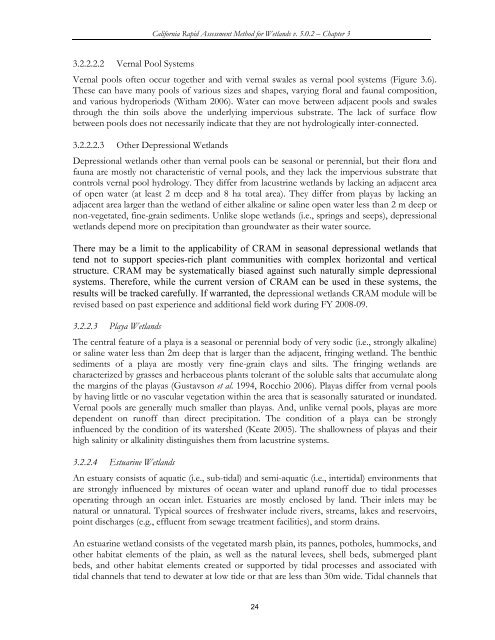California Rapid Assessment Method for Wetlands - State Water ...
California Rapid Assessment Method for Wetlands - State Water ...
California Rapid Assessment Method for Wetlands - State Water ...
Create successful ePaper yourself
Turn your PDF publications into a flip-book with our unique Google optimized e-Paper software.
<strong>Cali<strong>for</strong>nia</strong> <strong>Rapid</strong> <strong>Assessment</strong> <strong>Method</strong> <strong>for</strong> <strong>Wetlands</strong> v. 5.0.2 – Chapter 3<br />
3.2.2.2.2 Vernal Pool Systems<br />
Vernal pools often occur together and with vernal swales as vernal pool systems (Figure 3.6).<br />
These can have many pools of various sizes and shapes, varying floral and faunal composition,<br />
and various hydroperiods (Witham 2006). <strong>Water</strong> can move between adjacent pools and swales<br />
through the thin soils above the underlying impervious substrate. The lack of surface flow<br />
between pools does not necessarily indicate that they are not hydrologically inter-connected.<br />
3.2.2.2.3 Other Depressional <strong>Wetlands</strong><br />
Depressional wetlands other than vernal pools can be seasonal or perennial, but their flora and<br />
fauna are mostly not characteristic of vernal pools, and they lack the impervious substrate that<br />
controls vernal pool hydrology. They differ from lacustrine wetlands by lacking an adjacent area<br />
of open water (at least 2 m deep and 8 ha total area). They differ from playas by lacking an<br />
adjacent area larger than the wetland of either alkaline or saline open water less than 2 m deep or<br />
non-vegetated, fine-grain sediments. Unlike slope wetlands (i.e., springs and seeps), depressional<br />
wetlands depend more on precipitation than groundwater as their water source.<br />
There may be a limit to the applicability of CRAM in seasonal depressional wetlands that<br />
tend not to support species-rich plant communities with complex horizontal and vertical<br />
structure. CRAM may be systematically biased against such naturally simple depressional<br />
systems. There<strong>for</strong>e, while the current version of CRAM can be used in these systems, the<br />
results will be tracked carefully. If warranted, the depressional wetlands CRAM module will be<br />
revised based on past experience and additional field work during FY 2008-09.<br />
3.2.2.3 Playa <strong>Wetlands</strong><br />
The central feature of a playa is a seasonal or perennial body of very sodic (i.e., strongly alkaline)<br />
or saline water less than 2m deep that is larger than the adjacent, fringing wetland. The benthic<br />
sediments of a playa are mostly very fine-grain clays and silts. The fringing wetlands are<br />
characterized by grasses and herbaceous plants tolerant of the soluble salts that accumulate along<br />
the margins of the playas (Gustavson et al. 1994, Rocchio 2006). Playas differ from vernal pools<br />
by having little or no vascular vegetation within the area that is seasonally saturated or inundated.<br />
Vernal pools are generally much smaller than playas. And, unlike vernal pools, playas are more<br />
dependent on runoff than direct precipitation. The condition of a playa can be strongly<br />
influenced by the condition of its watershed (Keate 2005). The shallowness of playas and their<br />
high salinity or alkalinity distinguishes them from lacustrine systems.<br />
3.2.2.4 Estuarine <strong>Wetlands</strong><br />
An estuary consists of aquatic (i.e., sub-tidal) and semi-aquatic (i.e., intertidal) environments that<br />
are strongly influenced by mixtures of ocean water and upland runoff due to tidal processes<br />
operating through an ocean inlet. Estuaries are mostly enclosed by land. Their inlets may be<br />
natural or unnatural. Typical sources of freshwater include rivers, streams, lakes and reservoirs,<br />
point discharges (e.g., effluent from sewage treatment facilities), and storm drains.<br />
An estuarine wetland consists of the vegetated marsh plain, its pannes, potholes, hummocks, and<br />
other habitat elements of the plain, as well as the natural levees, shell beds, submerged plant<br />
beds, and other habitat elements created or supported by tidal processes and associated with<br />
tidal channels that tend to dewater at low tide or that are less than 30m wide. Tidal channels that<br />
24















